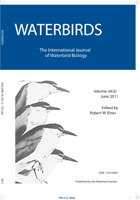Wetland-scale and landscape-scale descriptors were compiled at 123 wetlands where Least Bittern (Ixobrychus exilis) have been detected in Québec since 1986 to identify key attributes associated with Least Bittern occurrence. Land cover information extracted from Landsat-7 ETM imagery and road density were calculated for a 500-m buffer surrounding occupied wetlands and paired sites ten km away to compare to the regional landscape. Cattail (Typha spp.) was the dominant vegetation at 96 of 123 wetlands. Shrub swamps were used at eleven sites. Wetland area ranged from 0.5 ha to 983 ha and man-made impoundments accounted for 24% of occupied sites. The 500-m buffer surrounding occupied wetlands was dominated by urban areas, agriculture, forests or wetlands at four, 22, 21 and 32 sites, respectively. Mean wetland cover was higher in the 500-m buffer (37%) than in the regional landscape (4%) whereas agriculture cover was greater at paired sites (55%) than around occupied wetlands (28%). Cover of anthropogenic and forest areas did not differ between wetland buffers and paired sites. Mean road density was higher in the 500-m buffer around occupied wetlands (29.5 m/ha) than in the regional landscape (18.4 m/ha) suggesting that wetlands near roads may be more easily accessible to surveyors. Habitat use in Québec corresponds with known breeding habitat structure elsewhere in North America. Along with wetland creation and conservation initiatives of remaining small and large wetlands, Least Bittern conservation will benefit from regular monitoring of impoundments' operable conditions to prevent sudden habitat changes that may impact breeding birds.
How to translate text using browser tools
1 June 2011
Habitat Use by Least Bitterns (Ixobrychus exilis) in Québec
Benoît Jobin,
Pierre Fradette,
Sandra Labrecque
ACCESS THE FULL ARTICLE

Waterbirds
Vol. 34 • No. 2
June 2011
Vol. 34 • No. 2
June 2011
cattail
Ixobrychus exilis
Least Bittern
marsh birds
Québec
Wetlands




